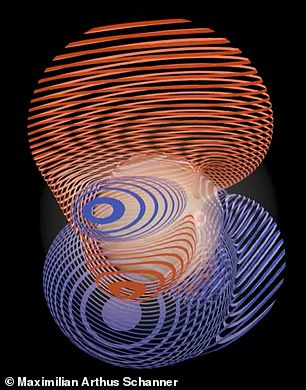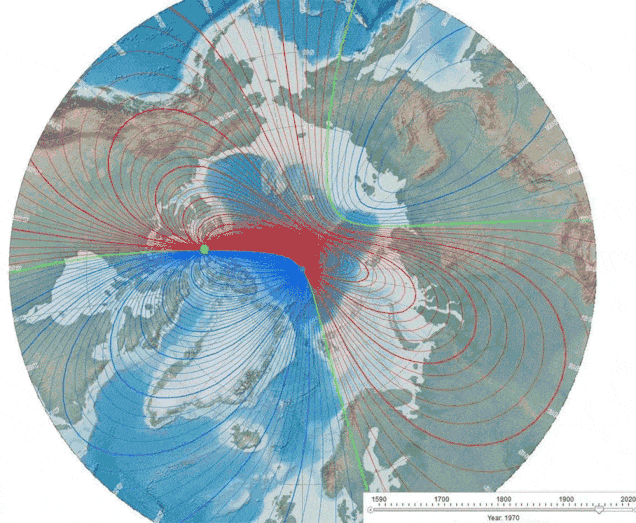[ad_1]
Every 200,000-300,000 years, Earth’s magnetic poles do something extraordinary.
They completely flip, meaning the North pole becomes the South, and vice-versa.
The last full reversal took place approximately 780,000 years ago – leaving some experts to predict another flip is imminent.
Now, researchers have created a terrifying soundscape to represent the chaos of this event.
Using paleomagnetic data – the record of Earth’s ancient magnetic field preserved in rocks – from around the globe, scientists have constructed a model of the magnetic field before, during and after this historic reversal.
They also created a musical piece – a ‘soundscape’ – to represent the haunting sounds of the flip, called the Matuyama-Brunhes reversal.
The team, from the Helmholtz Centre for Geosciences in Potsdam, Germany, used three violins and three cellos to create a ‘disharmonic cacophony’ that mirrors the complex dynamics of a flip.
The clip starts off as melodic and makes for pleasant listening as it represents the poles while stable. However, it sounds more erratic and eerie as the magnetic fields begin to flux and change.


Researchers have created a terrifying soundscape to represent the chaos of this event. The left part of the animation represents the magnetic field is a relatively stable state, however, the right represents it in a total state of flux, with the poles completely scrambled

Earth is surrounded by a system of magnetic fields called the magnetosphere. This shields our home planet from harmful solar and cosmic particle radiation, but it can change shape in response to incoming space weather from the Sun. Pictured: an artist’s impression
Earth’s magnetic field is generated by the roiling liquid metals deep beneath the crust.
It extends from the Earth’s interior into space, acting like a protective shield by diverting harmful charged particles from the Sun away from our planet.
A flip doesn’t happen overnight but takes place gradually, over centuries to thousands of years.
If a magnetic flip were to happen again, some experts claim it could render parts of Earth ‘uninhabitable’ by knocking out power grids.
Communication systems could be seriously disrupted, and compasses would point south – meaning Greenland would be in the southern hemisphere and Antarctica in the North.
While it sounds terrifying, and would leave life on our planet exposed to higher amounts of solar radiation, it’s unlikely to cause catastrophic events or mass extinctions.
Last year, researchers also transformed readings of an epic upheaval of Earth’s magnetic field that took place some 41,000 years ago.
The Laschamp event saw our planet’s magnetic North and South poles weaken, with the magnetic field tilting on its axis.

During a pole reversal, Earth’s magnetic North and South poles swap locations. While that may sound like a big deal, pole reversals are common in Earth’s geologic history. Pictured: an artist’s impression of Earth with its magnetosphere
The soundscape was captured using data from a constellation of European Space Agency satellites.
Researchers mapped the movement of Earth’s magnetic field lines during the event and produced a stereo sound version using natural noises including wood creaking and rocks falling.
The noises in the video represent a time when the Earth’s magnetic field was at just five per cent of its current strength.
While the Earth’s magnetic field did return to normal – over the course of around 2,000 years – its strength has decreased again by 10 per cent over the past 180 years, experts have found.
However, a mysterious area in the South Atlantic has emerged where the geomagnetic field strength is decreasing even more rapidly.
The area is called the South Atlantic Anomaly and has seen satellites malfunctioning over it several times due to exposure to highly charged particles from the sun.
This has led to speculation that Earth is heading towards a magnetic pole flip.
However, some experts have provide reassurance that the poles aren’t going to flip anytime soon.

A comparison between the present day geomagnetic field (top) and a potential ancient analogue at 600 BCE (bottom)
Researchers previously pieced together data on Earth’s geomagnetic field strength stretching back 9,000 years and say there’s no evidence a reversal is on the cards.
‘We have mapped changes in the Earth’s magnetic field over the past 9,000 years, and anomalies like the one in the South Atlantic are probably recurring phenomena linked to corresponding variations in the strength of the Earth’s magnetic field’, said Andreas Nilsson, a geologist at Lund University.
The team analysed burnt archaeological artefacts, volcanic samples and sediment drill cores – all of which carry information about Earth’s magnetic field.
Reassuringly, the team’s model suggests that the South Atlantic Anomaly will recover of its own accord and is unlikely to trigger the reversal that some have anticipated.
‘Based on similarities with the recreated anomalies, we predict that the South Atlantic Anomaly will probably disappear within the next 300 years, and that Earth is not heading towards a polarity reversal’, Mr Nilsson said.
[ad_2]
This article was originally published by a www.dailymail.co.uk . Read the Original article here. .


